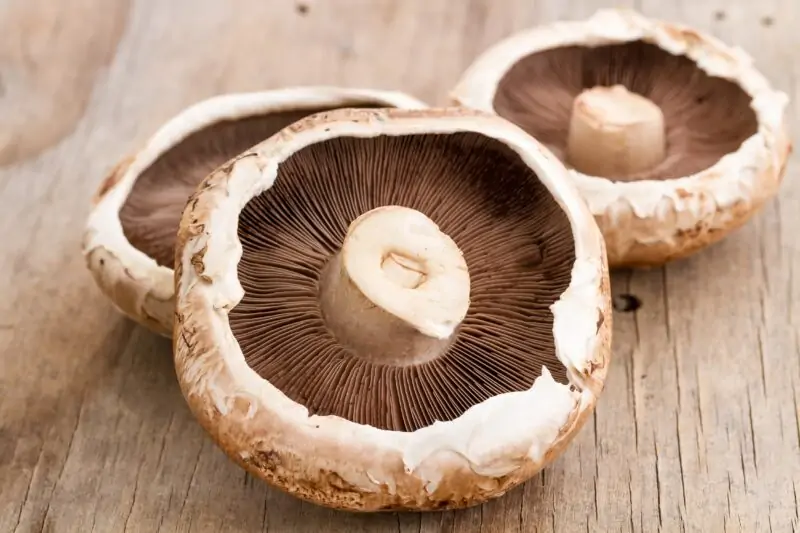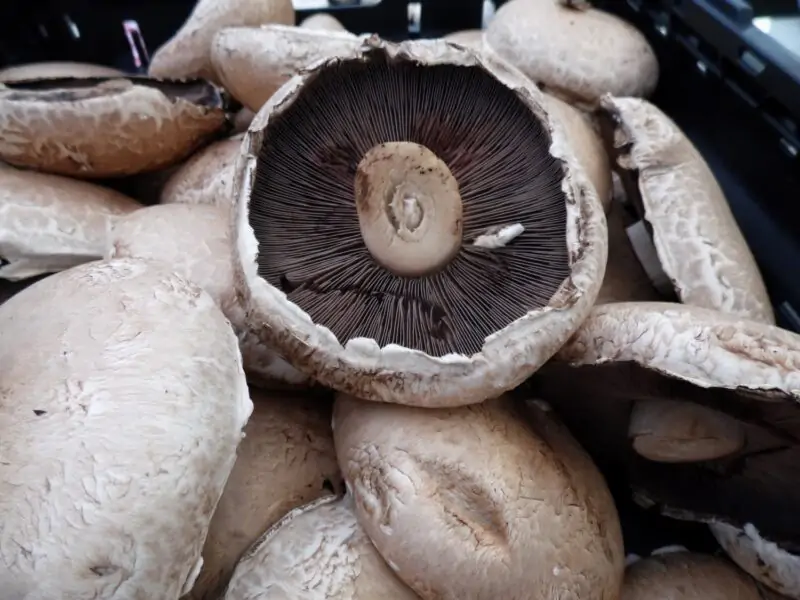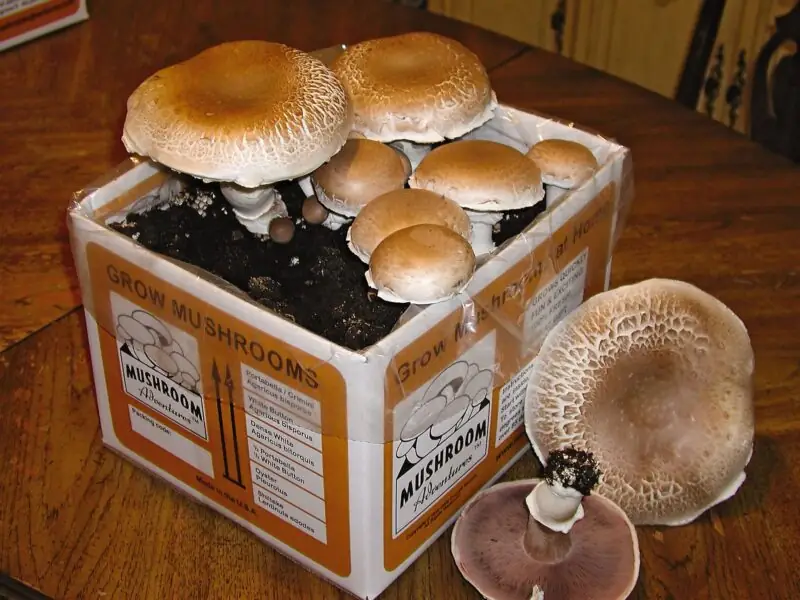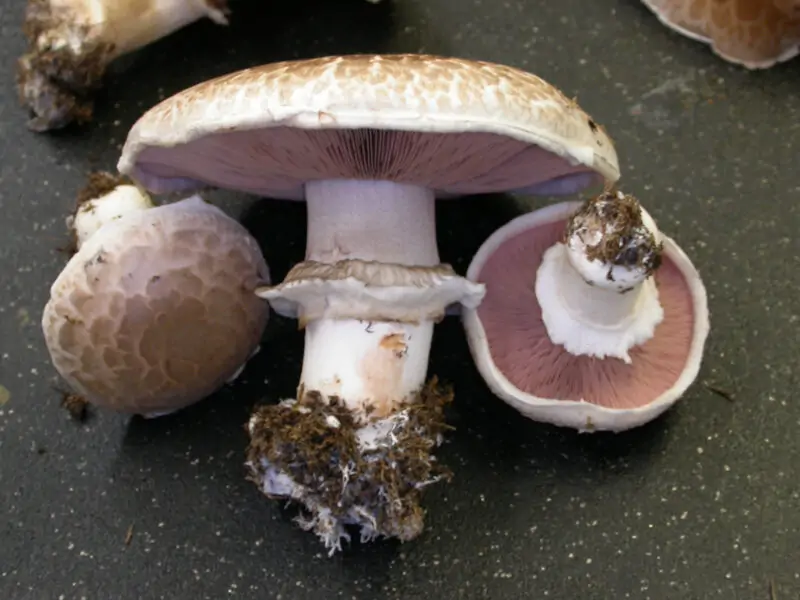How To Grow Portobello Mushrooms: At Home and Outdoors

Mushrooms are a versatile and delicious ingredient that can be used in many dishes. Portobello mushrooms, in particular, have become increasingly popular due to their meaty texture and rich flavor. Many people love them grilled or roasted as a vegetarian alternative to steak. But what if you could grow your own portobello mushrooms at home? Not only would it save you money on groceries, but it’s also an enjoyable hobby that yields fresh produce for your kitchen! In this article, we’ll cover everything you need to know about how to grow portobello mushrooms indoors and outdoors, including growing conditions and essential growing tips.
What Are Portobello Mushrooms?
Portobellos are actually just matured cremini (or baby bella) mushrooms with larger caps – they’re the same species of mushroom! They have thick stems with gills underneath the cap where spores develop. These large brownish-gray fungi have been around since ancient times but were first cultivated commercially in Pennsylvania during World War II.
In addition to being deliciously meaty when cooked properly, these fungi offer some nutritional benefits too – they’re low-calorie yet packed with protein and nutrients like vitamin D!
Portobello vs. Portabella: What’s the Difference?
You may see both spellings used interchangeably without any difference between them; however “portabello” is not considered correct by most mycologists who study these fascinating organisms. The term “portabella” was originally coined by American farmers trying to market larger versions of cremini as something new – more attractive than simply old big criminis – while “portobella” is just an incorrect spelling probably caused by confusion over whether or not there should be two Ls or two Bs–it doesn’t really matter which one we choose because they’re synonymous! So whether spelled “portabello” or “portabella,” don’t worry too much about choosing — focus instead on learning how to grow them.
Growing Portobello Mushrooms: Indoors vs. Outdoors

Before we dive into the details of how to grow portobellos, you need to decide whether you want to cultivate them indoors or outdoors. Both options have their pros and cons!
Growing portobello mushrooms indoors is a great choice if you live in an apartment or don’t have much outdoor space. It’s also easier than growing outside because it doesn’t require as much attention – just set up your mushroom kit and let nature do its thing! However, indoor cultivation can be expensive for beginners due to the cost of purchasing equipment like mushroom spores, peat moss, manure, etc., which are required for creating suitable growing conditions.
On the other hand, growing outdoors requires more work but provides greater yield potential with every crop cycle–and outdoor-grown portobellos tend to taste earthier too! To ensure that your mushrooms grow successfully, choose a suitable growing medium and maintain proper moisture levels by misting the mushrooms regularly.
Whether you’re growing your portobello mushrooms indoors or outdoors, you’ll need to order portobello spores or a mushroom kit from a gardening store. Sprinkle the spores onto the mushroom substrate, and make sure to keep the growing space clean to avoid contamination. Be patient as you wait for your mushrooms to grow, and once you see the mushroom heads, you’ll know your mushrooms are ready to harvest.
With the right knowledge and some dedication, you can enjoy delicious, home-grown portobello mushrooms all year round. So why not give it a try and start growing these tasty mushrooms today?
Let’s explore each option in detail starting with indoor cultivation:
Try Growing Portobello Mushrooms at Home
Indoor mushroom farming may sound intimidating at first but once you get started it becomes quite easy! Here are some steps that will help ensure success when cultivating these delicious fungi inside your home:
Materials Needed
- Mushroom spawn (portabello)
- Clean compost (manure-based works best)
- Peat moss
- Vermiculite
- A container large enough for all materials.
- An aquarium would suit well here.
Preparing The Substrate And Spawn
First things first: prepare a substrate by combining clean compost and peat moss in equal parts until they form moist clumps that hold together easily without being too wet or dry.
Once this mixture is ready, spread vermiculite over the top about two inches deep before adding spawn from either store-bought kits or online sources containing pure mycelium culture grown on sterilized grains such as rye berries.
Creating The Right Environment
After you have added the spawn, cover it with a layer of vermiculite and then place everything in your container. The ideal temperature for growing portobello mushrooms is between 60-75°F (15-25°C), which can be achieved by keeping them in a cool dark room or closet.
The fruiting process takes about two to three weeks after incubation, during which time they require high humidity levels (85%) so make sure that the area where your container is located remains damp at all times. You may want to mist them regularly using water from spray bottles.
Caring For Your Mushrooms
Once you see small pinheads forming on top of the substrate mix, increase air circulation by opening up any vents available within your indoor growing space–if there aren’t any fans nearby, just leave windows open if possible!
As soon as mushroom caps start flattening out, remove plastic bags covering containers and put under light sources such as fluorescent bulbs or natural sunlight – this will help prompt photosynthesis needed for healthy growth until finally getting matured enough around day 16/17 when harvesting becomes necessary.
Harvesting Portobello Mushrooms Indoors
When harvesting portobellos indoors, there are a few things worth remembering:
- Cut off these fungi at their base rather than pulling
- Use sharp scissors or a knife
- Don’t wait too long before picking since overripe specimens won’t taste good
Growing and Harvest Portobello Mushrooms Outdoors
Now let’s explore how cultivating outside works — here’s what you need to know:
Choosing The Right Location
Choose an outdoor location that receives plenty of sunshine but isn’t too exposed – direct sunlight can dry out mushrooms while strong winds could damage delicate stems. A shady spot would work well provided it gets some sun throughout each day.
Also, choose wisely regarding soil type: sandy soils don’t retain moisture very effectively; clay soils become hard quickly once dry. Ideally, you want a loamy soil with good drainage that also holds moisture well.
Preparing The Growing Bed
Begin by preparing the growing bed – follow these steps:
- Dig a trench about 12 inches deep and fill it with compost, peat moss, or aged manure.
- Mix in some straw to help improve water retention while keeping them from getting soggy
- Cover this mixture with black plastic sheeting to prevent weeds from sprouting up around your mushrooms
Introducing Mushroom Spores
After your prepared mushroom bed is complete, purchase spores online or at gardening stores–make sure they’re specifically for portobellos!
Next, sprinkle spore powder evenly over the top of the compost layer before covering everything again using another thin layer of soil followed immediately by more straw mulch on top as an added protective barrier against wind and light.
Then spray everything down thoroughly so that both substrate layers are moist enough for mycelium colonization to begin – daily watering is necessary until fruiting bodies start appearing.
Caring For Your Outdoor Mushrooms
As soon as portobello mushrooms begin forming into pinheads, make sure the surrounding area isn’t too dry – if needed, use sprinklers regularly–they need lots of moisture throughout their life cycle! And once caps have started flattening out, remove any coverings used during the incubation period and let nature take its course!
Keep an eye out for pests such as slugs, which love feeding upon young stems; otherwise, just wait patiently until matured specimens appear ready for harvesting — usually around day 14/15 depending on weather conditions.
Harvesting Portobello Mushrooms Outdoors
When it’s time to harvest your outdoor portobello mushrooms, follow these tips:
- Use a sharp knife or scissors to cut the mushrooms off at their base rather than pulling them out.
- Harvest the mushrooms when their caps have flattened out but before they become overripe, as their flavor and texture will be best at this stage.
- Store your harvested mushrooms in a paper bag in the refrigerator to help maintain their freshness.
By following these guidelines, you’ll be able to enjoy delicious, home-grown portobello mushrooms whether you’re cultivating them indoors or outdoors.
Using a Portobello Mushroom Growing Kit

If you’re looking for an easy and convenient way to grow your own portobello mushrooms at home, using a mushroom growing kit is the perfect solution. These kits provide everything you need to get started, from substrate and spores to instructions on how to care for your mushrooms as they grow.
Advantages of Using a Growing Kit
One of the biggest advantages of using a mushroom growing kit is that it takes all the guesswork out of starting your own mushroom garden. You don’t have to worry about sourcing materials or figuring out what kind of environment is best suited for portobellos – just follow the instructions included with your kit and watch as these delicious fungi sprout up before your eyes!
Another benefit is that these kits are extremely user-friendly. Even if you’ve never grown anything in your life, chances are good that you’ll be able to handle setting up one of these kits without any trouble.
Finally, since most growing kits come with enough supplies for several batches’ worth (or more) of mushrooms, you can enjoy fresh portobellos whenever you want them without having to constantly restock at the grocery store.
Steps for Growing Portobello Mushrooms with a Kit
- Choose Your Kit: There are many different types available online or at gardening stores – choose one based on its reviews and price point.
- Prepare Your Substrate: Most likely this will involve mixing composted manure with a vermiculite/peat moss blend.
- Sprinkle Spores Over Substrate: Mist lightly after covering spores with a thin layer of soil.
- Cover With Plastic Bag: This will keep moisture levels high while preventing contamination by other molds/fungi.
- Waiting Period Begins: Set aside in a warm/dark place where temperature remains around 70 degrees Fahrenheit for 10-14 days until small white growths called mycelium are visible.
- Uncover and Move to Light: Once the mycelium has grown, remove the plastic bag and move the container into an area with bright, indirect sunlight or under a grow light.
- Water Regularly: Mushrooms thrive in humid environments – misting them regularly will help maintain proper moisture levels.
- Harvest Your Portobello Mushrooms: They should be ready around three weeks after you’ve moved your kit to a lit place.
Harvesting Mushrooms from a Growing Kit

When it comes time to harvest your portobello mushrooms from their growing kit, there’s really not much more involved than picking them off of their substrate! Just use scissors or shears when cutting through stems (rather than pulling), so that new growth is encouraged.
Growing Portobello Mushrooms from Store Bought
Why not try growing your own at home! Not only is it a fun and rewarding experience, but it can also save you money in the long run. In this section, we’ll go over how to grow portobellos using store-bought mushrooms.
- First things first – when picking out your store-bought mushrooms, make sure they are fresh and healthy-looking. It’s important to note that some grocery stores may treat their mushrooms with chemicals that prevent further growth or spore production. To ensure success in growing your own, opt for organic or locally sourced options if possible.
- Once you have acquired your fresh portobellos, remove the stems from each mushroom cap and set them aside for later use (they can be used as part of the substrate). Using a clean spray bottle filled with water, mist both sides of each cap until they are damp but not soaking wet.
- Next up is creating an environment conducive to mushroom growth! This will involve preparing a substrate similar to what you would use in a mushroom growing kit, such as a mixture of composted manure and a vermiculite/peat moss blend. Place the prepared substrate in a suitable container, such as a plastic storage bin or a large pot.
- Next, break the removed stems into small pieces and mix them into the substrate. This will introduce the mushroom’s mycelium to the substrate and promote growth.
- Cover the substrate with a layer of plastic wrap or a plastic bag, ensuring there are small holes for air exchange. Place the container in a warm, dark area with a temperature of around 70 degrees Fahrenheit (21 degrees Celsius) for 10-14 days. During this time, the mycelium should start to grow and colonize the substrate.
- Once you see the mycelium growing, remove the plastic cover and move the container to a location with bright, indirect sunlight or under a grow light. Maintain a high humidity level by misting the substrate and mushrooms regularly, as portobello mushrooms thrive in a humid environment.
- Monitor the growth of your mushrooms, and when the caps start to flatten out, it’s time to harvest. Use a sharp knife or scissors to cut the mushrooms at the base of their stems, being careful not to damage the mycelium in the substrate. This will encourage new growth and allow you to enjoy multiple harvests from your store-bought mushroom setup.
Nutritional Value and Health Benefits of Portobello Mushrooms

Portobello mushrooms are nutrient-rich, containing protein, vitamins B6 and D. They’re low-calorie, with only 22 calories per 100g, making them great for weight loss diets. They’re also high in fiber for digestive health. Some studies suggest that they have anti-inflammatory properties due to beta-glucan content.
Frequently Asked Questions
Yes, with proper instructions, temperature, humidity, light, and substrate.
Portabella means “beautiful door” in Italian. It’s a large brown mushroom with a meaty texture. Portobello is dark brown and slightly larger than white button mushrooms.
They’re native to European grasslands, typically growing in manure-rich soil. Now found worldwide.
Possible, but mix with materials like straw, chicken manure, etc.
Improper storage or age can lead to sliminess, mushiness, and mold. Ensure freshness when buying.
Yes, but avoid undercooked or old ones, which can cause indigestion. Cooking is best.
A mix of horse/cow/chicken manure, straw, and gypsum, with a pH of 7-8.
Choose firm, clean specimens without bruises. Check gills and stem for freshness.
No direct sunlight, but indirect light is needed. Natural room lighting works.
Yes, baby bella is another name for crimini mushrooms, immature portobellos.
About 3-4 weeks from start to harvest with proper care.
Conclusion
Growing portobello mushrooms at home offers numerous benefits. Not only do you get to enjoy the satisfaction of cultivating your own fresh, nutritious, and delicious fungi, but you also have the opportunity to learn more about the growing process.
Whether you choose to grow portobellos from store-bought mushrooms, spores, or even a convenient growing kit, you’ll be able to experience the joy of watching them sprout and develop before your very eyes. And with the proper care and attention to detail, you’ll be rewarded with a bountiful harvest.
Remember to follow the guidelines for choosing, caring for, and harvesting your portobello mushrooms to ensure the best results. By understanding their nutritional value and health benefits, you’ll be even more motivated to incorporate these versatile fungi into your diet.
So why not get started on your own portobello mushroom growing adventure? The process may be challenging at times, but the end result is well worth the effort. Enjoy your homegrown portobellos in a variety of dishes, and share your success with friends and family. Happy growing!